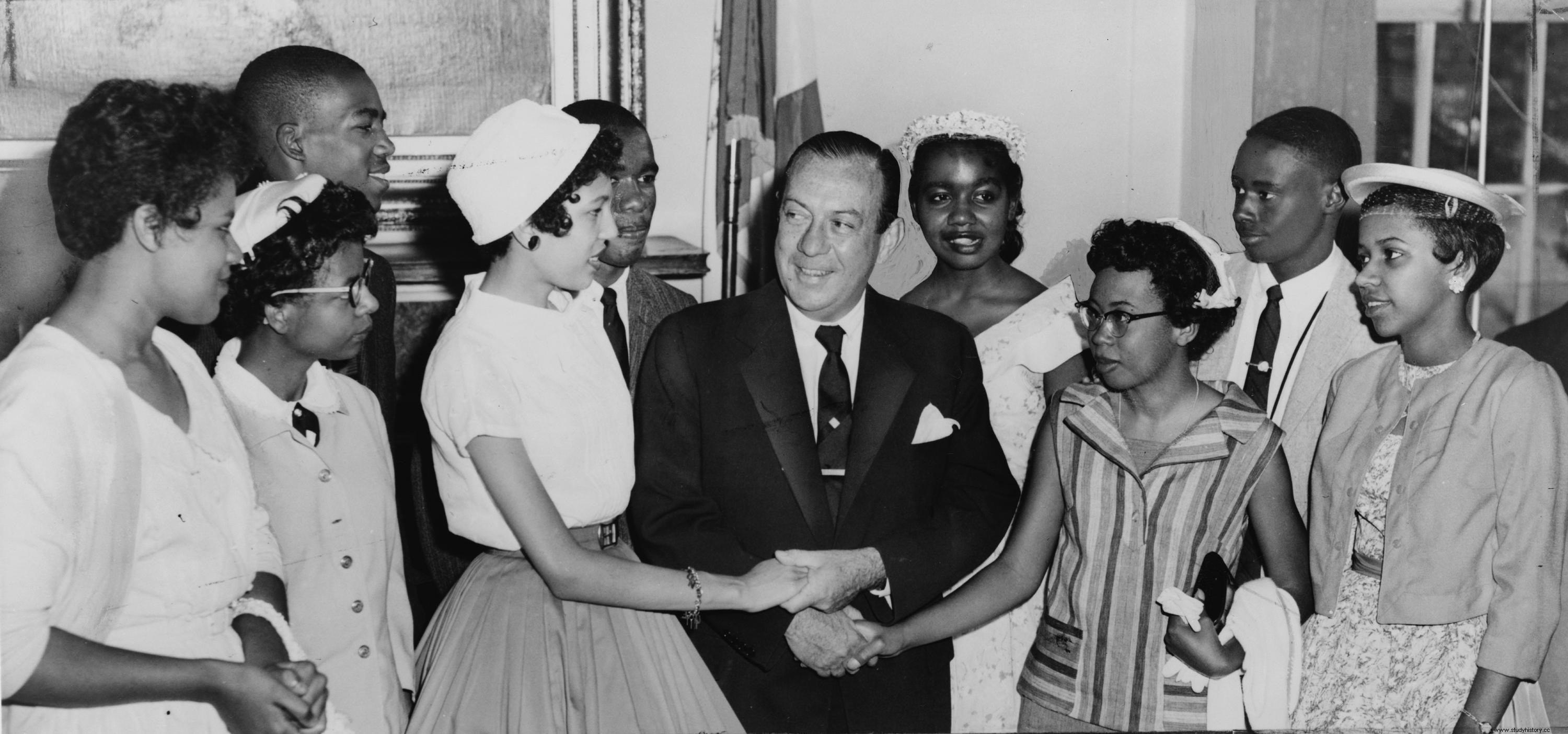Elizabeth Eckford (b. 1941) was among the first group of African-American students enrolled in a formerly whites-only school in Arkansas, known as the Little Rock Nine. She and her classmates had to face violence and hostility to be able to follow their studies.
The Brown v. Board of education
Elizabeth Eckford was born on October 4, 1941, in Little Rock (Arkansas) during a period of racial segregation in the United States. Schools are segregated, and Elizabeth attends a school for black students.
In May 1954, Brown v. Board of education of the United States Supreme Court declares racial segregation in public schools unconstitutional. The decision is neither accepted nor applied everywhere in the same way; in Arkansas, schools reserved for white students persist in refusing blacks.
The Little Rock Nine

In September 1957, nine black students were enrolled in Little Rock Central High School, which until then had been reserved for whites. Fifteen-year-old Elizabeth is in the group with Minnijean Brown-Trickey, Gloria Ray Karlmark, Melba Pattillo Beals, Thelma Mothershed, Ernest Green, Jefferson Thomas, Terrence Roberts and Carlotta Walls Lanier.
Hostile to desegregation, the governor of Arkansas Orval Faubus sends the National Guard to prevent the nine students from accessing the school. Aware of the possible abuses, the NAACP, in the person of Daisy Bates, decides to have the students escorted; but Elizabeth's family does not have a phone, and cannot be notified.
September 4, 1957
Elizabeth Eckford, she does not know that Faubus called the National Guard. She describes this morning of September 4, 1957 in these terms:
“I was not prepared for what actually happened. I was more concerned about what I would wear, whether we could finish my dress in time…what I was wearing was that okay, would it look good. (…) My mother was making sure everybody’s hair looked right and everybody had their lunch money and their notebooks and things. But she did finally get quiet and we had family prayer. I remember my father walking back and forth.
(I was unprepared for what happened. I was more concerned with what I was going to wear, if we were going to be able to finish my dress…if what I was wearing would be pretty… My mom made sure everyone got their hair done, got their lunch money, and their school stuff. But she finally got quiet, and we prayed together. I remember my dad pacing.)
 Elizabeth goes to school alone. When she sees the national guard near the establishment, she first imagines that they are there to protect it. But when she approaches, they cross their weapons to stop her. Elizabeth quickly realizes that it is she who is being denied access to school.
Elizabeth goes to school alone. When she sees the national guard near the establishment, she first imagines that they are there to protect it. But when she approaches, they cross their weapons to stop her. Elizabeth quickly realizes that it is she who is being denied access to school.
Elizabeth ends up turning around, harassed by a crowd of hundreds of white men, women, teenagers shouting insults at her and lynching threats. Photographer Will Counts immortalizes this moment, showing the young teenager followed by an angry crowd. Shocked, Elizabeth returns home in tears.
Sending the army to Arkansas
For the next few weeks, the Little Rock Nine study at home rather than try to go to high school, while President Dwight D. Eisenhower tries to convince Orval Faubus to withdraw the National Guard, and fails. At the end of September, the students, accompanied by city police, manage to enter the school through a secondary door.
The crowd of anti-desegregation howls with rage and takes over the school, dragging the young students to the principal's office, threatening them with death. As the situation threatens to escalate, one of the Nine hears an official say:
“We may have to let the mob have one of those kids, so we can distract them long enough to get the others out. (We may have to let the crowd have one of these kids, to distract them long enough to get the others out)
The next day, Eisenhower took control of the Arkansas National Guard and sent the army to Little Rock to accompany the students and protect them. This protection of the soldiers allows the Nines access to the high school, but does not prevent the constant harassment and acts of hatred and violence inside; Elizabeth will thus be pushed down the stairs within the establishment.
After the crisis
The Little Rock Nine are coming to the end of their year. At the start of the following school year, the Supreme Court ordered the immediate integration of black students into the schools of the city; in return and to prevent desegregation by all means, the governor prefers to close the schools. Elizabeth Eckford could not continue her studies in Little Rock and took correspondence courses before obtaining a history degree in Ohio.
Subsequently, Elizabeth served in the United States Army for five years as an information specialist. She will then work as a waitress, history teacher, social worker, judicial controller and journalist. She receives the Spingarn Medal from the NAACP, the Father Joseph Biltz Award and the Congressional Gold Medal American, highest civilian honor granted by Congress.
